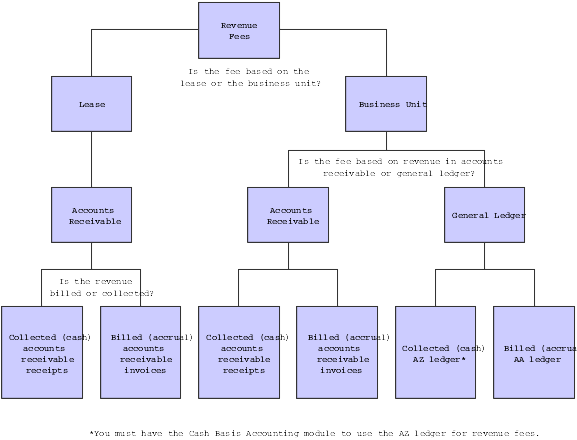Understanding Revenue Fee Processing
The flexibility of the revenue fee process enables you work with a variety of fees to produce invoices, vouchers, or intercompany journal entries. For example, a fee management company can create invoices to bill owners, or an owner can create vouchers to pay a leasing agent. If you bill one party and pay another, you can create a single journal entry to offset the revenue and expense accounts that are associated with the invoice and voucher specifications.
This diagram illustrates the primary decisions that affect the setup and calculation of revenue fees:

A fee is based on revenue from either an entire business unit or an individual lease. You specify whether the revenue is from a business unit or an individual lease by the fee type, which is a user-defined code in UDC table 15/FE. For a business unit, which relates to a management perspective, the revenue can be based on either the Customer Ledger table (F03B11, or one or more accounts in the Account Ledger table (F0911). For a lease, which relates to commissions, the revenue is based on the F03B11 table only because the lease number is a part of the F03B11 record, but not the F0911 record. Depending on the agreement that you make with the leasing agent, you can pay the commission immediately or pay the commission in increments. Commissions are based on rent only.
The revenue can be the amounts that have been either billed or collected (an accrual or cash basis, respectively). This action is controlled by the fee table.
Revenue Recognition for Real Estate Fees (Release 9.2 Update)
The EnterpriseOne system has been updated to meet the requirements of the FASB ASC 842 and IFRS 16 Leases accounting standards.
The system includes revenue recognition processing, as necessary, on invoices that are generated through the Real Estate Management system. To include invoices that are generated from these fees in the revenue recognition process, you must configure your revenue recognition triggers to identify these invoices.
Be aware that the system compares only the values in the AR section at the bottom of the Revenue Fee Master Revisions form to the defined trigger values when determining if a fee invoice should be included in revenue recognition processing.
See Setting Up Revenue Recognition Triggers for Real Estate Management in the JD Edwards EnterpriseOne Applications Accounts Receivable Implementation Guide.